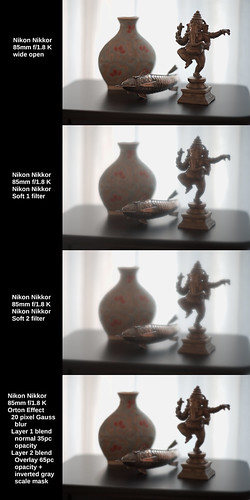I'm used to being able to evaluate optical performance based on the number of lines per mm something resolves in a 6:1 contrast ratio scene (ie: how "sharp" a lens is). I'm also used to being able to think about optical contrast performance based on reading Modulation Transfer Functions (ie: how much contrast a lens can pass through to the light sensitive material). I think we're all pretty good at understanding chromatic aberration, field curvature, and such things.
Out of focus rendition is a topic that gets, for me, a little subjective. Though many people talk about "bokeh" and seem to understand each other pretty well. But by the time we get to talking about Soft Focus lenses and filter, I think we find ourselves firmly into subjective terminology territory.
How do we talk about Soft
Focus photography? As several friends have pointed out over the years, we
really don't have a language for talking about nor evaluating image "softness."
Part of the problem, I feel, has to do with history and the influence of certain West Coast photographers and American critics on the global conversation of what is and is not acceptable photography. For whatever reasons, after passing through a period of Pictorialism it was collectively agreed that "sharp" is correct and everything else (soft focus lenses, filters, and image manipulations) is not.
Technically, part of the problem is image viewing size changes what we as viewers might find "pleasing." It seems that too large a viewing size can soften a scene up to and beyond the limits of "pleasing." Yet, a smaller viewing size of the same image can be found to be "pleasing." Whatever the squishy, subjective, and imprecise word "pleasing" means.
I've thought about these things off and on for years. In our current late-pandemic time I've taken up once again a quest to learn a bit more about soft focus images and how they are made. Yes, Good Sir Knight, it may be a Worthy Quest. Or not. I'll see how things turn out after a few more articles on the subject.
I will start by considering something I felt would be obvious. Filters, both analog and digital. Filters are an inexpensive and easy way of modifying a scene when using just about any lens.
If you like and study his images, there are three things that come into
play that contribute to Hamilton's signature style "softness." Shooting
against the light is one such thing. We can see this from his earliest
publications. Along with at least one image manipulation (which we will
consider in a future article) Max Stolzenberg nearly exclusively shooting against the light. If we look back to the earlier Pictorialists, they too used to sometimes shoot against the light.
Following their example I chose a scene that deliberately shoots against the light. No reflected fill is added and the foreground objects are "wrapped" in delicate light. The exposure is +1ev in an attempt to capture shadow detail against a very bright background scrim.
Technically, the following image comparison used a Sony A7 and a Nikon Nikkor 85mm f/1.8 K. I photographed the scene without and with filtration. The filters were a Nikkor #1 and a Nikkor #2 Soft. Then I illustrate the use of a digital filter and it's effect on the unfiltered starting image. The digital technique is called the "Orton Effect."

Thoughts -
Wide open, the Nikon Nikkor 85mm f/1.8 H, HC, and K lenses (seemingly all versions have the very same optical implementation) are brilliant for the way they sharp from wide open and give a
subtly beautiful under-correct for spherical aberration behind the point of
focus. I really enjoy working with this lens.
The Nikon Nikkor Soft #1 and #2 filters give a distinctive 1970's "look" to the scene. Images are generally soft all over and highlights can glow. With few exceptions, I don't yet see a compelling correspondence between filtration and early Pictorialist works. This makes sense to me as Pictorialists used specially designed optics to achieve their unique style of "softness" and I haven't read where they used filtration to achieve the effects they did.
Compared with what we see from David Hamilton's work neither can I see where there is a good correspondence between his image "look" and filtration. Compared with Max Stolzenberg's work, the #2 Nikkor Soft comes closest to achieving Max's "style", but to my eyes it is not an exact match.
Considering the "Orton Effect" digital softening approach I don't see a strong correlation between the digital filter and the images of David Hamilton nor Max Stolzenberg. However, I see where a careful crafts-person could begin to emulate some of the Pictorialist era "styles." Of course this approach wasn't available to Pictorialists, but the potential to digitally recreate the "feeling" of the earlier era could be there.
In the next article I will begin to consider Pictorialist style optical "softness" in image making.
No comments:
Post a Comment